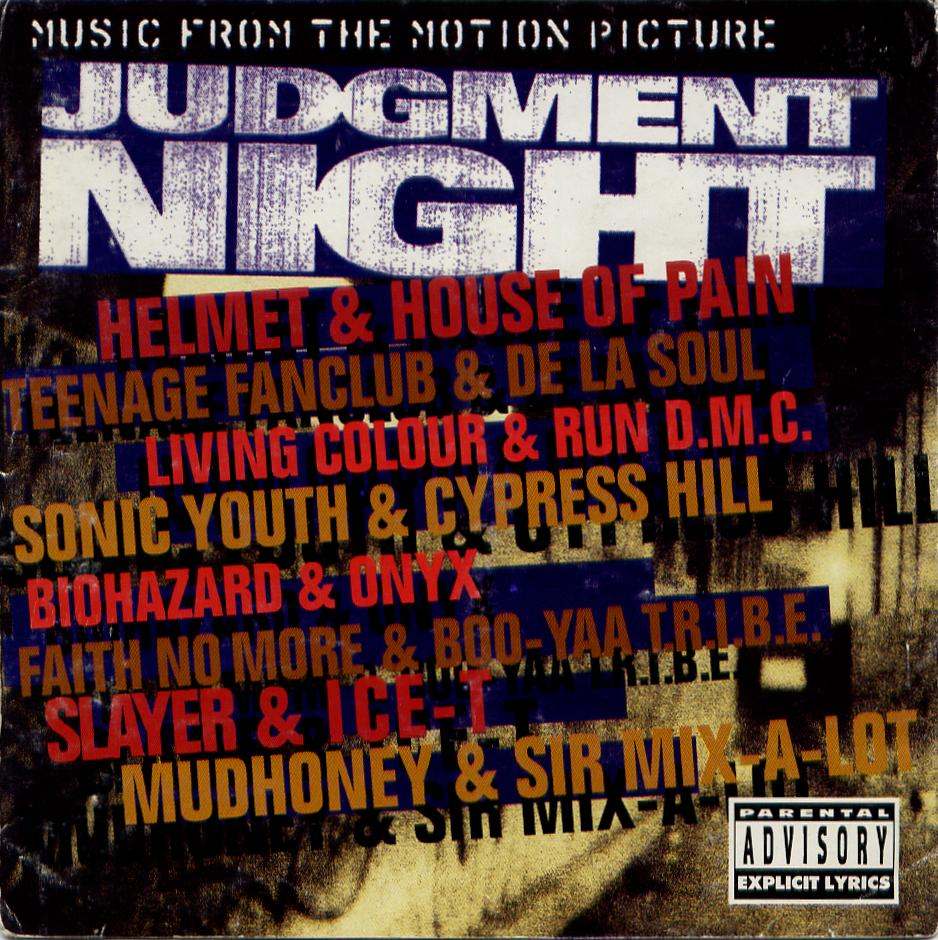There were precedents for this: Run-DMC with Aerosmith, Public Enemy with Anthrax, the Kerry King guitar solo on "No Sleep Til Brooklyn." Ice-T was already touring and recording with a metal band, Body Count, and they'd already released one song ("Cop Killer") that turned out to be way more infamous than any rap records he'd ever release. Rage Against The Machine and Downset already had dudes rapping splenetically over demonic riffage. And since it was the early '90s and white people were still figuring out what rap was, people would talk about Anthony Kiedis or Mike Patton or Les Claypool as rock-rappers, too, even though, I mean, good lord, come on. But before the Judgment Night soundtrack, nobody had attempted a full-scale all-star album-length collision of rap and hard rock, the day's two dominant testosterone-outlet musics. In the long run, it wouldn't lead anywhere good. Directly, it would lead to stunt-casting soundtrack albums for movies like Spawn (rock bands working with dance producers!) and Blade II (dance producers working with rappers!). Less directly, it would help market-test the rap-metal mookery revolution that would start in earnest with the self-titled Korn album a year later. But in the short term? If you were a teenage boy with a whole lot of pent-up shit? And you needed some intense wild-out music to keep your levels even? This album was an absolute godsend.
I've never seen Judgment Night, the 1993 B-movie where Emilio Estevez and Cuba Gooding, Jr. play drunk yuppies who get lost in Chicago and have to battle gang leader Denis Leary. (I'll type that again: "gang leader Denis Leary.") I've never been remotely interested in seeing it. It is nobody's idea of an essential film. But played the living shit out of the soundtrack album. The entire concept -- metal bands link with rappers, yell a lot -- was pure gimmicky, and not all of it worked, but the album is a delirious go-nuts blast, a total symphony of hardheadedness. With a few scant exceptions, the songs went like this: Band busts out the most rhythmic and bass-heavy riff it can manage, rappers shout about stepping on your face, the end. The bands' singers often don't appear on the songs,and rappers often take the bands' thunder as an excuse to use only their simplest cadences, but it doesn't matter; things mesh anyway. House Of Pain's Everlast rhymes "Harvey Keitel" with "living hell" over the detuned guitars of Helmet frontman Page Hamilton. Onyx's Sticky Fingaz screams that he's trying to make the white man call him master while on a song with actual white men Biohazard. On their lovably demented Fatal collab "Time To Die," Therapy? come up with a deeply evil riff that someone would later rip off for Taz's entrance music in ECW. And just as he's almost done kicking mack shit over Mudhoney's fizzy surf-punk, fellow Seattle resident Sir Mix-A-Lot cackles and shouts, "Just lost my street credibility, y'all!," like he hadn't already made "Baby Got Back."
That's another thing: This was pre-ProTools, and the bands and rappers generally like they were in the same place at the same time when they were making these songs. Sometimes, the bands dominate. Slayer and Ice-T's "Disorder" has basically no rap in it whatsoever; it's a hardcore/thrash crossover banger with Ice-T yelling about the L.A. riots and sounding like nobody so much as Suicidal Tendencies' Muke Muir. Other times, the bands barely seem to be present. The Cypress Hill/Sonic Youth team-up "I Love You Mary Jane" is pretty much just a Black Sunday-era Cypress Hill get-high song, except with a few stray clings and clangs and a breathy Kim Gordon vocal loop. (Gordon, it bears mentioning, is probably the only female musician who was involved in this thing at all.) And sometimes, neither one dominates, and the song just sort of drifts off into the ether. When Cypress Hill reappears with Pearl Jam on "The Real Thing," everyone sounds just about asleep, while Run-DMC, the original kings of rap-rock crossover, treat their Living Colour collab "Me, Myself & My Microphone" like it's a dry run for their godawful-clumsy 2001 nu-metal cash-in album Crown Royal, and Faith No More waste a promisingly ominous groove on shouty nonentities Boo-Yaa T.R.I.B.E. Even those songs, though, have a fascinating time-capsule gooniness working toward them, and the same impulses that led to those songs also gave us Dinosaur Jr. and Del The Funky Homosapien getting way loopy together on "Missing Link."
And then there's De La Soul and Teenage Fanclub's starry-eyed "Fallin'," the best song on the album and the only one that really bucks the all-aggro vibe. "Fallin'" is a small masterpiece, and it's the one moment on the album where bands and rappers work to find some real middle ground, rather than everyone just acting as tough as possible. Musically, it's an amiable, shambling country-rap lope, all acoustic guitars and finger-snaps. Lyrically, it's the De La guys waxing honestly and humbly about lost fame and lost buzz, finding the song's groove and using its contemplative vibe to think hard about lost opportunity. But the whole time, they're having audible fun. At the end, someone sings Duice's "Dazzy Duks" really loud. The song points to a different path that the soundtrack could've taken, a different path that rap-rock itself could've taken. And even if it never influenced a single other musician, it's still out there, glimmering brightly, waiting for you to discover it.
[videoembed size="full_width" alignment="center"][/videoembed]
[videoembed size="full_width" alignment="center"][/videoembed]






